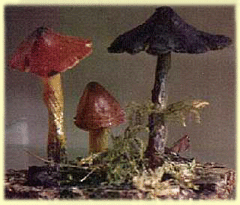
 |
|
|
Ecology of Grassland
Fungi
Grasslands are the product of centuries of human agricultural activity and represent the dominant habitat type in the
UK (and especially Wales), covering some 65% of the total land area.
Traditional grasslands in the form of herb-rich meadows also represent a significant but largely neglected reservoir of indigenous biodiversity for the British Isles. However, over the past 50 years it is reliably estimated that some 98% of haymeadow habitats have been destroyed, partly through urban or suburban building programmes but mainly through agricultural intensification in the form of ploughing and high level fertiliser input.
The resultant loss of biodiversity among plant and animal species (e.g. orchids, birds, butterflies) has received some public attention but it is also the case that there is concomitant disappearance of microbial biodiversity following disturbance.
Research at Aberystwyth concentrates on elucidating the role of fungi in
semi-natural and low input grassland systems. Three doctoral research
programmes are currently underway:-
This doctoral research programme is investigating several aspects of the biology of the 
Despite their ubiquity, scientific investigation of these fungi has hitherto been limited to taxonomic studies. The main reason for this is that more informative methods of microbiological investigation have been predicated on the ability to culture of the organism in question, whereas members of the genus Hygrocybe have yet to be successfully maintained in axenic culture. However, the recent biological revolution which has exploited the
techniques of molecular biology (PCR and DNA sequencing) now permits investigation of previously uncultured (and frequently unknown) microbes.
As a result the biology of uncultured micro-organisms is probably the most exciting challenge of current microbiology, with significant implications for our understanding microbial ecology and of microbial biodiversity. The biotechnological "spin-off" has not escaped the attention of the pharmaceutical industry which is currently investing heavily in such research.
Arbuscular mycorrhizal fungi (AMF) are ubiquitous in soils infecting most plant taxa and facilitating plant nutrient uptake (especially P). The fungal hyphae penetrate the root epidermis and grow throughout the cortical tissue invading individual cells where highly branched intracellular structures, arbuscules, are formed (fig. 1). These are thought to be the major site of nutrient exchange. Extraradical hyphae grow out into the external environment, foraging for nutrients. This doctoral programme (a jointly between UWA, IGER and the University of Kent) is examining the effect of AMF interactions with White Clover (Trifolium repens), concentrating on the intraradical development of the mycorrhizas and tripartite partner ships with other microbes. Isolates of Rhizobium spp. have been shown to both promote and inhibit AMF infection, since both symbioses result in an increased mineral supply and carbon drain on the host. AMF and Rhizobium spp. are being ‘trapped’ from conventionally and organically managed agricultural grasslands, with an aim of comparing the effects on plant growth and development of various host/AMF/Rhizobium combinations (fig. 2). Fusarium spp. are similarly ubiquitous in soils and can cause ‘damping off’ in clover seedlings, as well as a range of other diseases in other plants. Plants are dual-inoculated with Fusarium spp. and AMF to determine whether mycorrhizal colonisation can limit pathogen infection. Molecular studies are centred
on the use of the PCR-based mitochondrial markers. These will
provide a method for quantificiation and identification of AMF symbionts
in clover roots and provide insight into AMF community structure in
different ecosystems. Effect of disturbance on biodiversity and population structure of rhizospere fungi in grasslands Lizzie Wilberforce Rhizosphere fungi belonging to the Ascomycete form-genus Fusarium are ubiquitous in soils but generally associated with disease (vascular wilt, damping off, ear blight etc) of a wide range of crop plants. However, in natural plant communities Fusarium spp. are abundantly found as endophytes of plant roots without any obvious damaging effect. This doctoral programme funded by the
National Botanic Garden of
Wales and the Immediate objectives include developing a protocol for the efficient isolation of Fusarium from root samples, and the development of molecular and spectroscopic methods for rapid identification of isolates.
|
 |
| Last Updated 06/06/00 | Designed and Developed by Sharon Nicholson |